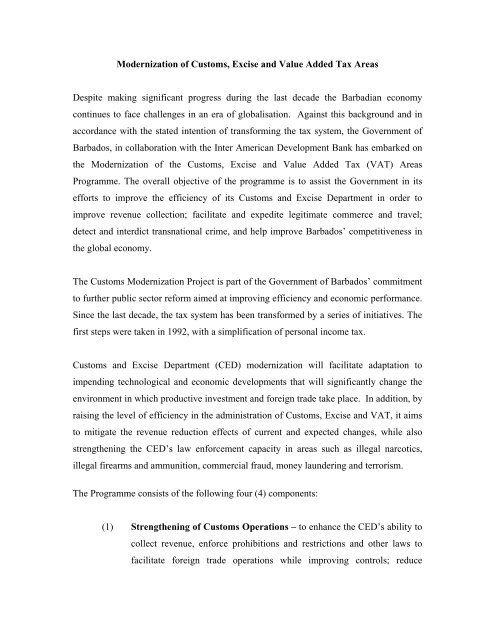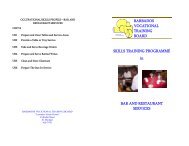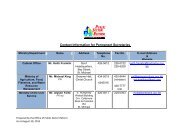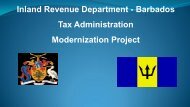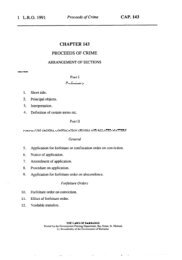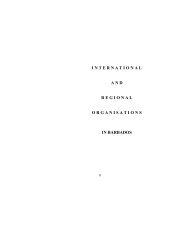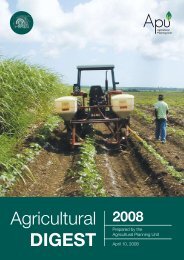Modernization of Customs, Excise and Value Added Tax Areas ...
Modernization of Customs, Excise and Value Added Tax Areas ...
Modernization of Customs, Excise and Value Added Tax Areas ...
- No tags were found...
Create successful ePaper yourself
Turn your PDF publications into a flip-book with our unique Google optimized e-Paper software.
<strong>Modernization</strong> <strong>of</strong> <strong>Customs</strong>, <strong>Excise</strong> <strong>and</strong> <strong>Value</strong> <strong>Added</strong> <strong>Tax</strong> <strong>Areas</strong>Despite making significant progress during the last decade the Barbadian economycontinues to face challenges in an era <strong>of</strong> globalisation. Against this background <strong>and</strong> inaccordance with the stated intention <strong>of</strong> transforming the tax system, the Government <strong>of</strong>Barbados, in collaboration with the Inter American Development Bank has embarked onthe <strong>Modernization</strong> <strong>of</strong> the <strong>Customs</strong>, <strong>Excise</strong> <strong>and</strong> <strong>Value</strong> <strong>Added</strong> <strong>Tax</strong> (VAT) <strong>Areas</strong>Programme. The overall objective <strong>of</strong> the programme is to assist the Government in itsefforts to improve the efficiency <strong>of</strong> its <strong>Customs</strong> <strong>and</strong> <strong>Excise</strong> Department in order toimprove revenue collection; facilitate <strong>and</strong> expedite legitimate commerce <strong>and</strong> travel;detect <strong>and</strong> interdict transnational crime, <strong>and</strong> help improve Barbados’ competitiveness inthe global economy.The <strong>Customs</strong> <strong>Modernization</strong> Project is part <strong>of</strong> the Government <strong>of</strong> Barbados’ commitmentto further public sector reform aimed at improving efficiency <strong>and</strong> economic performance.Since the last decade, the tax system has been transformed by a series <strong>of</strong> initiatives. Thefirst steps were taken in 1992, with a simplification <strong>of</strong> personal income tax.<strong>Customs</strong> <strong>and</strong> <strong>Excise</strong> Department (CED) modernization will facilitate adaptation toimpending technological <strong>and</strong> economic developments that will significantly change theenvironment in which productive investment <strong>and</strong> foreign trade take place. In addition, byraising the level <strong>of</strong> efficiency in the administration <strong>of</strong> <strong>Customs</strong>, <strong>Excise</strong> <strong>and</strong> VAT, it aimsto mitigate the revenue reduction effects <strong>of</strong> current <strong>and</strong> expected changes, while alsostrengthening the CED’s law enforcement capacity in areas such as illegal narcotics,illegal firearms <strong>and</strong> ammunition, commercial fraud, money laundering <strong>and</strong> terrorism.The Programme consists <strong>of</strong> the following four (4) components:(1) Strengthening <strong>of</strong> <strong>Customs</strong> Operations – to enhance the CED’s ability tocollect revenue, enforce prohibitions <strong>and</strong> restrictions <strong>and</strong> other laws t<strong>of</strong>acilitate foreign trade operations while improving controls; reduce
administrative costs for users <strong>of</strong> services provided by <strong>Customs</strong>; <strong>and</strong> reducethe cost <strong>of</strong> customs administration. The deliverables for this componentinclude: (i) implementation <strong>of</strong> a post-clearance audit system aimed atformalizing a risk analysis methodology as a st<strong>and</strong>ard procedure; (ii)training <strong>of</strong> IT human resources in Internet-related technologies in order toadequately prepare staff to deal with new technologies; (iii) drafting <strong>of</strong><strong>Customs</strong> legislation reform, aimed at updating current legislation, takinginto account recent advances in technology <strong>and</strong> modern procedures; (iv)establishment <strong>of</strong> an online authorization system for other agencies in orderto provide an automated interface so that government agencies are able toauthorize the clearance <strong>of</strong> goods in real time (e.g., health <strong>and</strong> agriculturalrelated products); (v) implementation <strong>of</strong> workflow <strong>and</strong> documentmanagement system aimed at establishing a system that will help automatecustoms procedures <strong>and</strong> provide support documents scanned <strong>and</strong> availablethrough automated means; (vi) provision <strong>of</strong> IT infrastructure for thecomplete automation <strong>of</strong> the CED; <strong>and</strong> (vii) achievement <strong>of</strong> ISO 9001certification in order to help the CED’s efforts to improve currentprocedures <strong>and</strong> quality.(2) Modernising <strong>of</strong> the Administration <strong>of</strong> the <strong>Value</strong> <strong>Added</strong> <strong>Tax</strong>: - toimprove the efficiency <strong>of</strong> VAT by strengthening the process <strong>of</strong>registration, certification, filing <strong>of</strong> returns <strong>and</strong> payments, as well as theselection <strong>of</strong> audit cases <strong>and</strong> control. In this regard, the component willinclude the following deliverables: (i) development <strong>of</strong> a strategic IT planaimed at facilitating the implementation <strong>of</strong> a new information system tomanage the VAT system in Barbados; (ii) review <strong>of</strong> current legislation <strong>and</strong>the drafting <strong>of</strong> an amendment to the VAT legislation in order to allow forthe incorporation <strong>of</strong> technological elements into the VAT system; (iii)development <strong>and</strong> implementation <strong>of</strong> a new information system providingtracking case assignment; selection <strong>of</strong> cases for auditing based on crossreferencing<strong>and</strong> risk analysis; arrears classification; systematic exchange
<strong>of</strong> information among <strong>Customs</strong> <strong>and</strong> <strong>Excise</strong> Department, Inl<strong>and</strong> RevenueDepartment <strong>and</strong> other agencies; (iv) establishment <strong>of</strong> a risk analysisstrategy for audit selection, providing support for the selection <strong>of</strong> cases,based on cross-referencing third-party information <strong>and</strong> risk analysis; <strong>and</strong>(v) execution <strong>of</strong> arrears collection clearance, which will allow for theh<strong>and</strong>ling <strong>and</strong> management <strong>of</strong> arrears accounts. The h<strong>and</strong>ling <strong>of</strong> caseassignment <strong>and</strong> tracing will be based on criteria such as amount <strong>and</strong> age <strong>of</strong>debt or taxpayer history.(3) Modernisation <strong>of</strong> <strong>Excise</strong> <strong>Tax</strong>es: - to reform the <strong>Excise</strong> control system, inparticular to transform the system from the physical stationing <strong>of</strong> <strong>of</strong>ficersin <strong>Excise</strong> facilities to a control system, relying mainly on periodic audits<strong>and</strong> a computerised system. This component includes the followingdeliverables: (i) development <strong>of</strong> a strategic plan for excise <strong>and</strong> newprocedures <strong>and</strong> the definition <strong>of</strong> guidelines to improve current processes,especially those related to audit <strong>and</strong> control; (ii) review <strong>of</strong> legislation <strong>and</strong>drafting <strong>of</strong> amendments in order to provide support for audit-basedcontrols; (iii) the development <strong>of</strong> an IT strategic plan aimed at improvingcurrent procedures, including the specifications <strong>of</strong> a new informationsystem to manage excise processes; <strong>and</strong> (iv) the implementation <strong>of</strong> newinformation systems, following the IT strategic plan in order to replace allcurrent manual procedures.(4) Strengthening <strong>of</strong> the Administrative Support <strong>Areas</strong>: - to reinforce thesupport areas <strong>of</strong> CED in order to provide a better service at a lower cost totechnical areas. This component includes the following deliverables, (i)the development <strong>of</strong> personnel pr<strong>of</strong>iles <strong>and</strong> procedures manuals; (ii) theestablishment <strong>of</strong> a training system <strong>and</strong> strengthening <strong>of</strong> policy, aimed atimproving efficiency <strong>and</strong> effectiveness; (iii) implementation <strong>of</strong> permanentinternal controls aimed at strengthening the monitoring <strong>of</strong> compliance <strong>and</strong>
applicability <strong>of</strong> procedures <strong>and</strong> regulations; <strong>and</strong> (iv) establishment <strong>of</strong> apermanent planning system in order to increase productivity through betterplanning.Specifically, the programme seeks (i) to facilitate import <strong>and</strong> export trade <strong>and</strong> strengthenthe <strong>Customs</strong> Administration by harmonizing <strong>and</strong> simplifying current procedures,improving the audit capacity <strong>and</strong> the institutional abilities to prevent <strong>and</strong> fighttransnational crime <strong>and</strong> its negative consequences; (ii) to improve compliance with theVAT <strong>and</strong> <strong>Excise</strong> <strong>Tax</strong> obligation through the modernization <strong>of</strong> the main administrativeprocesses, especially those corresponding to tax collection <strong>and</strong> audit; (iii) to strengthenthe Department’s institutional management capacity through the improvement <strong>of</strong>administrative processes <strong>and</strong> the implementation <strong>of</strong> mechanisms for the integration <strong>and</strong>strengthening <strong>of</strong> support systems (planning, internal control <strong>and</strong> human resourcesmanagement).Apart from improving the collection <strong>of</strong> customs revenue, the programme also seeks toreduce the average clearance time for imports <strong>and</strong> exports; a reduction in VAT arrears; areduction in filing late returns, electronic filing <strong>of</strong> VAT returns, a reduction in the time toprocess VAT refunds, <strong>and</strong> a reduction in the operational costs for the <strong>Excise</strong> Division.The total cost <strong>of</strong> the programme is estimated at $11 million <strong>of</strong> which $8.8 million will befinanced by the Bank as a reimbursable loan. The Government <strong>of</strong> Barbados willcontribute $2.2 million. Given the scope <strong>of</strong> the project, the technical execution whichcommenced in January <strong>of</strong> this year is estimated to be completed in 42 months.In order to effectively manage the program a structure consisting <strong>of</strong> a SteeringCommittee, Project Coordinating Unit <strong>and</strong> four working teams at the level <strong>of</strong> beneficiaryunits has been established. The responsibility <strong>of</strong> the Steering Committee is to givestrategic <strong>and</strong> policy directives on the project. The Committee comprises representativesfrom the <strong>Customs</strong> <strong>and</strong> <strong>Excise</strong> Department, the Ministry <strong>of</strong> Finance, the AuditDepartment, Data Processing Department, Statistical Services, Accountant General’s


